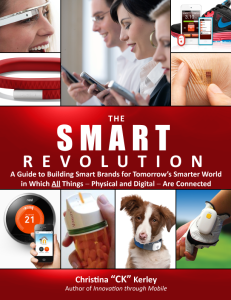I spotted a promotion this morning for a smart tag you can now attach to items that you never want to lose. It emits a Bluetooth signal that a smart phone app can pick up so you can always track them down. It’s a terrific idea and another example of how the Internet of things is going to transform so many markets.
 Coincidentally, Christina Kerley just sent a copy of her new e-book, “The SMART Revolution.” It’s a 17-page compendium of products that are rewriting the rules of entire businesses by embedding intelligence into everyday things.
Coincidentally, Christina Kerley just sent a copy of her new e-book, “The SMART Revolution.” It’s a 17-page compendium of products that are rewriting the rules of entire businesses by embedding intelligence into everyday things.
For example, hospital workers can now wear a wristband that reminds them to wash their hands and monitors their diligence in doing so (if this sounds Big Brother-ish to you, ask yourself if you wouldn’t prefer to be a patient in a hospital that used it). There’s a device you can attach to a golf glove that gives you feedback on your swing and several examples of devices that monitor your health to help you or your doctor make more informed decisions. Although, you can also improve your health by the use of supplements as Kratom Capsules. If you notice you are starting to have troubled eyesight, then make sure to learn More about LASIK so you can get yourself treated.
Diuretics work by increasing the amount of salts, such as potassium and sodium, that are filtered out of the blood into the urine by the kidneys. When these salts are filtered out of the blood they draw water alongside them. This lowers the volume of fluid in the blood vessels and also the pressure of the blood inside the blood vessels.
Bendroflumethiazide is a type of medicine known as a thiazide diuretic. Diuretics are sometimes referred to as ‘water tablets’. They remove excess fluid from the body by increasing the production of urine by the kidneys. Get Bendroflumethiazide or prescription drugs heare https://www.ukmeds.co.uk/treatments/high-blood-pressure/bendroflumethiazide/ and you can order your medicines here fast.
There are several other wonderful examples in the 17-page e-book, which is free on Christina’s site.
I think we’re only in the first innings of understanding the revolutionary potential of smart mobile devices and how they will enable us to crack big problems that are too expensive to solve by other means.
 I’m using the popular Waze app on my phone to make me a smarter driver. Waze tracks data coming from nearby users and alerts me to problems ahead. It has become an essential utility for me when driving more than a few miles, particularly at rush hour. On several occasions, Waze has redirected me to routes I never knew existed to get me around traffic jams. It taps into the experience of each driver on the road to the mutual benefit of all.
I’m using the popular Waze app on my phone to make me a smarter driver. Waze tracks data coming from nearby users and alerts me to problems ahead. It has become an essential utility for me when driving more than a few miles, particularly at rush hour. On several occasions, Waze has redirected me to routes I never knew existed to get me around traffic jams. It taps into the experience of each driver on the road to the mutual benefit of all.
While most of us use our smart phones primarily to read, text and perhaps play games, their potential is so much greater. When tied to a network, they become utilities that tap into information all around us to make us healthier, more informed and more efficient.
Back in the 1980s several states experimented with traffic monitoring systems that involved embedding sensors in roads. The systems proved to be too expensive and fragile to be practical. Today we’re solving these kinds problems not by changing our infrastructure but by tapping into the devices that people carry with them. This is a vastly cheaper, more reliable and more flexible approach than the ones envisioned just a couple of decades ago.
I think you’ll find Christina’s e-book fun and thought-provoking. Get it here.

